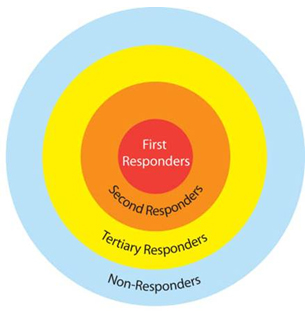Public/Private Sector Partnerships for Community Preparedness
 From a community standpoint, there have been many concerns and a change of vision regarding emergency preparedness, response, and recovery. It is necessary that public and private sectors work together to return the community to a sense of normalcy. The public and private sectors bring areas of expertise and resources to the table that are required for rapid response and recovery. Public/private sector partnerships enable the entire community to work together, combine resources, and utilize a communal approach to emergency management.
From a community standpoint, there have been many concerns and a change of vision regarding emergency preparedness, response, and recovery. It is necessary that public and private sectors work together to return the community to a sense of normalcy. The public and private sectors bring areas of expertise and resources to the table that are required for rapid response and recovery. Public/private sector partnerships enable the entire community to work together, combine resources, and utilize a communal approach to emergency management.
There are four goals for public/private sector partnerships in regards to emergency preparedness. These goals are:
Goal 2. Strengthen the availability of resources by completing a public/private sector resource analysis.
Goal 3. Create a comprehensive community-wide plan that utilizes the strengths and resources of both the public and private sectors.
Goal 4. Initiate cooperative training and exercises bringing together the public and private sectors based on the assessed risks.
Dadisho’s observations here are important. He’s correctly identified some primary issues law enforcement, and by extension the community, is forced to face when attempting to mitigate the ever-growing crime of identity theft. Identity theft is unlike traditional crimes and therefore cannot usually be investigated with traditional crime solving methodology. In addition, law enforcement officers (LEOs) are often not given proper information regarding the necessity of a police report for victim mitigation. Mitigation of this type of case requires greater cooperation between the individual victims, the law enforcement community, and the financial institutions and other entities that also become victims by proxy of these crimes.
To achieve these four goals, it is vital that everyone involved understand their roles and expectations. One way to consider roles and expectations is through the Concentric Circle Model for Emergency Response. The model is composed of four concentric circles, each representing a different type of emergency responder.

The following is a description of each circle from the inside to the outside of the model.
- First Responders: Individuals who are responsible for protecting and preserving life, property, evidence, and the environment at the incident site. First responders include local law enforcement, fire, HazMat, and emergency medical services.
- Secondary Responders: Individuals who provide care to patients after they are triaged by the first responders and/or first receivers. This includes all members of a hospital staff, in some cases state level first responders, and emergency responders from the federal level.
- Tertiary Responders: Individuals mostly focused on the short and long-term incident recovery. This group includes clean-up contractors, debris removal personnel, rebuilding operations, support organizations, volunteers, local community groups, and businesses and corporations with a local presence.
- Non-Responders: Individuals who are not members of the other responder groups but who are affected and will be part of any response to a crisis event.
One example of this type of model in action is the Northwest Arkansas Emergency Response Leadership Roundtable (NWAERLR). NWAERLR is a group composed of all types of emergency responders that represent the key disciplines necessary to successfully coordinate planning for, responding to, and recovering from emergencies in their community. Membership includes law enforcement (city, county, state), fire, EMS, medical facilities, Fortune 500 companies, and non-profit organizations just to name a few. NWAERLR’s mission is to develop processes, procedures, and intra-agency agreements designed to enhance the protection of the people, facilities, and infrastructure in Northwest Arkansas. It accomplishes this by leveraging required assets in the public and private sector and effectively collaborating to identify risks, mitigate threats, and prepare responses to emergencies of all types. NWAERLR supports the National Response System and Homeland Security by minimizing the risks to the public and improving response capabilities across all communities and constituencies in Northwest Arkansas. The group also plays a key role in local, state, and national exercises and is a great asset in the success and implementation of Arkansas’ Business Emergency Operations Center in partnership with the Arkansas Department of Emergency Management.
Emergencies and crisis situations require complex, cooperative response that involves the public and private sectors and clearly defined, documented agreements. The “whole community” approach to emergency management, beginning at the core levels with citizen personal preparedness, engaging the private sector (business and industry, non-governmental organizations, educational institutions, faith-based organizations, volunteers, etc.), and the public sector better ensures timely recovery from any type of event. Understanding roles and having documented public/private partnerships in place enables a community to be prepared to act when a crisis occurs, initiate a joint response, and better enable them to heal and recover.
Ricky Tompkins, EdD
Associate Vice President for Research and Planning
Chief Diversity Officer
NorthWest Arkansas Community College
In collaboration with Melissa Bradley, COPS Office
Police and People Who Stutter | Partnerships for Preparedness | Events with the Potential to Go Viral | Tribal Policing Partnerships | Solving Missing and Unidentified Persons Cases | Advancing Police Legitimacy | Did you know…?
